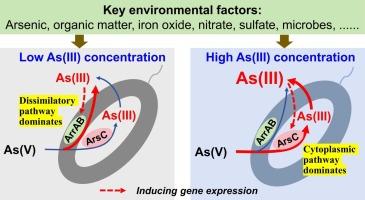微生物还原砷酸盐的生态之谜中缺失的部分
IF 11.3
1区 环境科学与生态学
Q1 ENGINEERING, ENVIRONMENTAL
引用次数: 0
摘要
砷污染及其相关的健康风险已引起广泛关注。在厌氧条件下,当砷酸盐[As(V)]被微生物通过细胞质和异化途径还原为亚砷酸盐[As(III)]时,砷的流动性和毒性增加。然而,这两种途径在环境中的相对重要性尚不清楚,限制了我们有效预测和调节砷环境行为的能力。在这里,我们回顾了细胞质或异化途径在环境中起主要作用的报道,并指出了它们的局限性。然后总结了影响微生物As(V)还原的关键环境因素。基于对两种As(V)还原途径相关基因表达的研究,我们假设在相对较高的环境As(III)浓度下,细胞质途径占主导地位,而在低浓度下,异化途径更为显著。未来的研究需要验证这一假设,并且可以在不同的环境样品和梯度下研究As(V)还原基因的表达与As(III)浓度的关系。本文章由计算机程序翻译,如有差异,请以英文原文为准。

Missing pieces in the puzzle of ecology of microbial arsenate reduction
Arsenic pollution and its associated health risks have raised widespread concern. Under anaerobic conditions, arsenic mobility and toxicity increase when arsenate [As(V)] is reduced to arsenite [As(III)] by microbes through the cytoplasmic and dissimilatory pathways. However, the relative importance of these two pathways in the environment remains unclear, restricting our ability to effectively predict and regulate the environmental behavior of arsenic. Here, we review reports that declared a major role of the cytoplasmic or dissimilatory pathway in the environment and point out their limitations. We then summarize the key environmental factors influencing microbial As(V) reduction. Based on studies examining the expression of genes involved in the two As(V) reduction pathways, we hypothesize that the cytoplasmic pathway predominates at relatively high environmental As(III) concentrations, while the dissimilatory pathway is more significant at low concentrations. Future research is needed to test this hypothesis, and the expression of As(V)-reducing genes as a function of As(III) concentration can be investigated with various environmental samples and gradients.
求助全文
通过发布文献求助,成功后即可免费获取论文全文。
去求助
来源期刊

Journal of Hazardous Materials
工程技术-工程:环境
CiteScore
25.40
自引率
5.90%
发文量
3059
审稿时长
58 days
期刊介绍:
The Journal of Hazardous Materials serves as a global platform for promoting cutting-edge research in the field of Environmental Science and Engineering. Our publication features a wide range of articles, including full-length research papers, review articles, and perspectives, with the aim of enhancing our understanding of the dangers and risks associated with various materials concerning public health and the environment. It is important to note that the term "environmental contaminants" refers specifically to substances that pose hazardous effects through contamination, while excluding those that do not have such impacts on the environment or human health. Moreover, we emphasize the distinction between wastes and hazardous materials in order to provide further clarity on the scope of the journal. We have a keen interest in exploring specific compounds and microbial agents that have adverse effects on the environment.
 求助内容:
求助内容: 应助结果提醒方式:
应助结果提醒方式:


